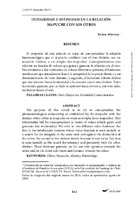| dc.rights.license | Licencia de Creative Commons Reconocimiento-NoComercial-CompartirIgual 4.0 Internacional (CC BY-NC-SA 4.0) | |
| dc.creator | Albertsen, Torben | |
| dc.date.accessioned | 2019-10-29T12:14:52Z | |
| dc.date.available | 2019-10-29T12:14:52Z | |
| dc.date.issued | 2015-12-01 | |
| dc.identifier.citation | Albertsen, T. (2015). Integridad e intimidad en la relación Mapuche con los otros. Avá. Revista de Antropología. Posadas: UNaM. FHyCS. PPAS; (27), 141-158. | |
| dc.identifier.issn | 1851-1694 | |
| dc.identifier.other | RA-215 | |
| dc.identifier.uri | https://hdl.handle.net/20.500.12219/2018 | |
| dc.identifier.uri | http://www.ava.unam.edu.ar/images/27/pdf/n27a08.pdf | |
| dc.description | Fil: Albertsen, Torben. Universidad de Santiago de Chile. Instituto de Estudios Avanzados. Comisión Nacional de Investigación Científica y Tecnológica; Chile. | es_AR |
| dc.description.abstract | El propósito de este artículo es tratar de conceptualizar la relación fenomenológica que el mapuche establece con el otro distinto, sea un mapuche distinto o un wingka (no-mapuche). Conceptualizamos esta relación en función de valores que guían y generan la relación con el otro. Nos referimos a dos horizontes de valores diferentes: primero, el horizonte norakizuam que inicialmente busca la integridad de lo propio frente a y en distanciamiento del otro distinto; y segundo, el horizonte nütram-kimün que inicialmente busca la intimidad y la cercanía con el otro distinto. Estos horizontes generan, por un lado la apertura hacia el otro y, por otro lado, los límites frente al otro. | es_AR |
| dc.description.abstract | The purpose of this article is to try to conceptualize the phenomenological relationship as established by the mapuche with the distinct other, other as mapuche or other as wingka (non-mapuche). This relationship will be conceptualized in terms of values which guide and generate this relationship. We refer to two different value horizons: the first is the norakizuam horizon whose value function is seen initially as a search for the integrity of the same over and against the distinction of the other; the second is the nütram-kimün horizon whose value function is seen initially as the search for intimacy and proximity with the other distinct. These horizons generate on the one side openness towards the other and on the other side limits and distance towards the other. | en |
| dc.format | application/pdf | |
| dc.language.iso | spa | es_AR |
| dc.publisher | Universidad Nacional de Misiones. Facultad de Humanidades y Ciencias Sociales. Secretaría de Investigación y Postgrado. Programa de Postgrado en Antropología Social | es_AR |
| dc.rights.uri | http://creativecommons.org/licenses/by-nc-sa/4.0/deed.es | |
| dc.source | Avá. Revista de Antropología (Misiones), 12-2015; (27): pp. 141-158 http://www.ava.unam.edu.ar/index.php | |
| dc.subject | Otro | es_AR |
| dc.subject | Mapuche | es_AR |
| dc.subject | Alteridad | es_AR |
| dc.subject | Conocimiento | es_AR |
| dc.subject | Other | en |
| dc.subject | Alterity | en |
| dc.subject | Knowledge | en |
| dc.title | Integridad e intimidad en la relación Mapuche con los otros | es_AR |
| dc.type | info:eu-repo/semantics/article | |
| dc.type | info:ar-repo/semantics/artículo | |
| dc.type | info:eu-repo/semantics/publishedVersion | |




